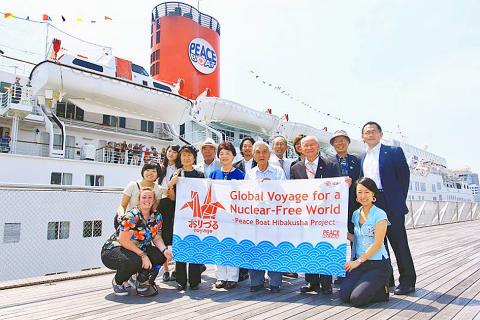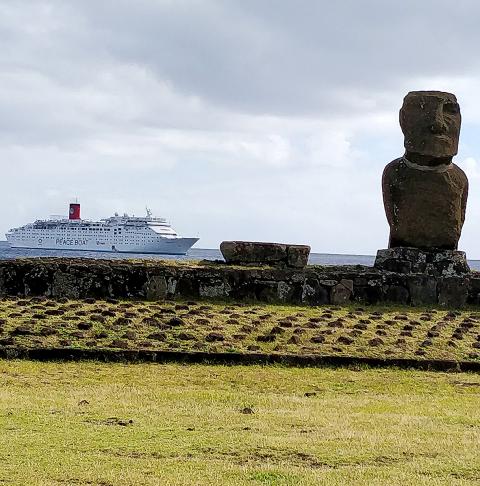After arriving in Hsinchu at the age of 16, Lee Yong-soo was repeatedly raped. She had been catching snails in what is today South Korea’s Daegu when she was kidnapped by a Japanese soldier and sent to Taiwan to serve as a sex slave for the Japanese military. She wouldn’t return home until the end of World War II.
Lee is among hundreds of thousands of women from throughout Asia, euphemistically know as “comfort women,” who were abducted from their homes to service Japanese soldiers in occupied territories before and during the war. Since 1998, she has traveled throughout the world discussing her experiences as a sex slave, a story that forms part of a lecture by Akira Kawasaki about using past atrocities to discuss peace education.
Kawasaki, a member of the Executive Committee of Peace Boat, a Japan-based international NGO working to promote peace, human rights and sustainability, will give the talk on Sunday as part of the Lung Yingtai Cultural Foundation’s Taipei Salon. The talk, in English, will be moderated by Shaw Mai-yi (邵梅儀), an academic at the Hong Kong University of Science and Technology.

Photos courtesy of ICAN
“Peace Boat has promoted dialogue among Japanese, Korean and other Asian participants in pursuit of building a common history ... and a shared commitment to not repeat [past] mistakes, while promoting rights, dignity of and healing for those affected,” Kawasaki tells the Taipei Times.
It’s a project that is perhaps needed as much today as ever before. With authoritarianism on the rise throughout the globe and as Japanese Prime Minister Shinzo Abe continues a campaign of denial about Japan’s atrocities during World War II, Kawasaki’s goal to educate the younger generation will only grow in importance.
SEX SLAVES

Photo courtesy of Wikimedia Commons
Kawaskai says that because the Japanese education system largely avoids this part of its World War II history, “many Japanese participants are shocked to listen to the brutal memories,” as told by Lee he said.
Japan’s current political climate, Kawasaki adds, plays a role in this.
“[T]he current Japanese political leaders, including the prime minister himself and those supporting him, have been promoting an ideological campaign to deny the past which has had certain impact on the public opinions of the Japanese people,” Kawasaki said.
Which is why, he added, that Peace Boat is critically important because the kinds of grass-roots education that it uses will “bear fruit in the long term to restore the Japanese people’s common sense [and] admit to past crimes, to make their apologies and become a responsible player to build peace in the region.”
PEACE BOAT
Peace Boat is a novel concept. It was begun in 1983 by Japanese university students Yoshioka Tatsuya and Kiyomi Tsujimoto in response to Japan’s whitewashing of its World War II history. Since then, it has broadened its mandate to include raising awareness and building connections with like-minded NGOs throughout the globe that work for peace, human rights, environmental protection and sustainable development.
Peace Boat also refers to one of the two large passenger ships, Ocean Dream and Zenith, embarking under the name of the NGO for in situ peace education. Since its founding, the organization has made over 100 voyages, sending over 70,000 participants to 270 ports.
Peace Boat is set to make a stop at Keelung in December next year.
Participants include university students and young professionals, but also those like Ryutaro Honda, a Japanese soldier during World War II who, until his death in 2010, traveled with Peace Boat to share his experiences of the war’s “insanity.”
Kawasaki says that Honda visited the Nanjing Massacre Museum to meet with the bereaved families, so as “to achieve a people-to-people reconciliation after the World War II in creating a foundation of peace in the region.”
NUCLEAR WEAPONS
Kawasaki will also draw on his experience as a member of the International Steering Group of the International Campaign to Abolish Nuclear Weapons (ICAN), a civil society coalition that won the Nobel Peace Prize in 2017, to discuss nuclear disarmament.
With North Korea already launching a number of missiles this year, and earlier this week offering the US an ominous “Christmas gift” if it doesn’t scale back its nuclear program, not to mention China continuing its saber-rattling over Taiwan, a nuclear incident in East Asia seems inevitable.
Kawasaki has little patience for deterrence, a theory promoted by many politicians that nuclear states will not attack each other because of the possibility of mutually assured destruction.
“The claim that nuclear weapons bring about international peace and security, or the so-called nuclear deterrence theory, lacks credibility... [T]he very existence of nuclear weapons have brought us to the brink of wars and crises. As long as nuclear weapons exist, there remain real risks that those are detonated either by design or accident,” he says.
Kawasaki will employ the personal experiences of hibakusha, or those who suffered from the after effects of the US dropping atomic bombs on Hiroshima and Nagasaki at the end of World War II. Kawasaki says that hibakusha play a fundamental role in spreading the message of humanitarian consequences of nuclear weapons.
“Humanitarian impact is just two words,” he told NHK Newsline in 2017. “But by listening to their storytelling, the first-hand experiences, face-to-face from a real human being, it has a very big impact on an audience. And almost everybody around the world knows the name of Hiroshima or Nagasaki.”
He added that nuclear weapons are often viewed as a “an international power game” because few have first-hand experience of the after effects.
“So, the first-hand testimony of Hiroshima and Nagasaki survivors significantly changes people’s perceptions about nuclear weapons,” he said.
As for a complete ban on nuclear weapons, Kawasaki doesn’t mince words.
“We have to choose the end of nuclear weapons or the end of us,” he says.

This month the government ordered a one-year block of Xiaohongshu (小紅書) or Rednote, a Chinese social media platform with more than 3 million users in Taiwan. The government pointed to widespread fraud activity on the platform, along with cybersecurity failures. Officials said that they had reached out to the company and asked it to change. However, they received no response. The pro-China parties, the Chinese Nationalist Party (KMT) and Taiwan People’s Party (TPP), immediately swung into action, denouncing the ban as an attack on free speech. This “free speech” claim was then echoed by the People’s Republic of China (PRC),

Exceptions to the rule are sometimes revealing. For a brief few years, there was an emerging ideological split between the Democratic Progressive Party (DPP) and Chinese Nationalist Party (KMT) that appeared to be pushing the DPP in a direction that would be considered more liberal, and the KMT more conservative. In the previous column, “The KMT-DPP’s bureaucrat-led developmental state” (Dec. 11, page 12), we examined how Taiwan’s democratic system developed, and how both the two main parties largely accepted a similar consensus on how Taiwan should be run domestically and did not split along the left-right lines more familiar in

Most heroes are remembered for the battles they fought. Taiwan’s Black Bat Squadron is remembered for flying into Chinese airspace 838 times between 1953 and 1967, and for the 148 men whose sacrifice bought the intelligence that kept Taiwan secure. Two-thirds of the squadron died carrying out missions most people wouldn’t learn about for another 40 years. The squadron lost 15 aircraft and 148 crew members over those 14 years, making it the deadliest unit in Taiwan’s military history by casualty rate. They flew at night, often at low altitudes, straight into some of the most heavily defended airspace in Asia.

Many people in Taiwan first learned about universal basic income (UBI) — the idea that the government should provide regular, no-strings-attached payments to each citizen — in 2019. While seeking the Democratic nomination for the 2020 US presidential election, Andrew Yang, a politician of Taiwanese descent, said that, if elected, he’d institute a UBI of US$1,000 per month to “get the economic boot off of people’s throats, allowing them to lift their heads up, breathe, and get excited for the future.” His campaign petered out, but the concept of UBI hasn’t gone away. Throughout the industrialized world, there are fears that